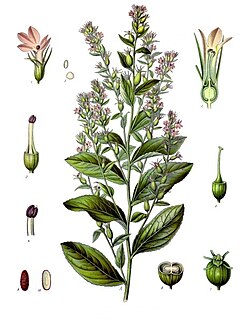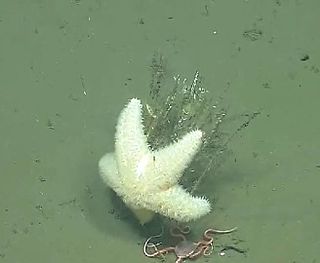
Malvidin is an O-methylated anthocyanidin, the 3',5'-methoxy derivative of delphinidin. As a primary plant pigment, its glycosides are highly abundant in nature.

Hexamita is a genus of parasitic diplomonads. It is related to Giardia. H. columbae and H. meleagridis live in the intestines of birds. H. muris and H. pitheci live in the intestines of mammals. H. salmonis and H. truttae live in the intestines of fish.

Opisthorchis felineus, or cat liver fluke is a trematode parasite that infects the liver in mammals. It was first discovered in 1884 in a cat's liver by Sebastiano Rivolta of Italy. In 1891, Russian parasitologist, Konstantin Nikolaevich Vinogradov (1847–1906) found it in a human, and named the parasite a "Siberian liver fluke". In the 1930s, helminthologist Hans Vogel of Hamburg published an article describing the life cycle of Opisthorchis felineus.
Beddomeia inflata is a species of very small freshwater snail that has a gill and an operculum, an aquatic operculate gastropod mollusk in the family Hydrobiidae. This species is endemic to Australia.

Lobelia inflata, also known as Indian tobacco or puke weed, is a species of Lobelia native to eastern North America, from southeastern Canada south through the eastern United States to Alabama and west to Kansas.

Utricularia inflata, commonly known as the swollen bladderwort, inflated bladderwort, or large floating bladderwort, is a large suspended aquatic carnivorous plant that belongs to the genus Utricularia. It is a perennial that is native to the southeastern coastal plains of the United States. It has often been confused with U. radiata, which is similar but smaller than U. inflata. Since 1980, U. inflata has been reported to exist in locations beyond its traditional range, such as the Adirondack Mountains in New York, southeastern Massachusetts, and in Washington State. Studies on the populations in the Adirondacks suggest that an introduction of U. inflata to a location where it naturalizes can lead to altered sediment chemistry by reducing the net primary productivity of native species. It is also listed by the state of Washington as a problematic species because of the dense mat-forming habit of this aquatic Utricularia. It is one of the few carnivorous plants that can be invasive.

Chloris is a widespread genus of plants in the grass family, known generally as windmill grass or finger grass.
†Samoana inflata was a species of air-breathing land snail, a terrestrial pulmonate gastropod mollusk in the family Partulidae.
Granigyra inflata is a species of sea snail, a marine gastropod mollusk, unranked in the superfamily Seguenzioidea.
Atlanta inflata is a species of sea snail, a holoplanktonic marine gastropod mollusk in the family Atlantidae.
Glycyrrhiza inflata is a plant species in the genus Glycyrrhiza from China, with common name Chinese licorice. A related species, G. uralensis, however, is more likely the licorice species one finds in traditional Chinese medicine.
Pocillopora inflata is a species of stony coral in the family Pocilloporidae. It was first described by Peter William Glynn in 1999. It is found growing on coral reefs in the tropical eastern Pacific Ocean but is nowhere abundant.

Poraniopsis inflata, the spiny sea star, is a species of starfish in the family Poraniidae. It is native to the Pacific Ocean and is found in deep water off the coast of North America.

Hottonia is a genus of aquatic flowering plant in the family Primulaceae. It comprises two species, both of which are known by the common name featherfoil:

Scopimera inflata is an Australian endemic species of sand bubbler crab common to wave exposed and estuarine sandy tropical and subtropical beaches of eastern Australia. Scopimera inflata are sand coloured and small sized with adults growing to 12mm across. The species occur in aggregations just below the high tide mark with females and smaller individuals mainly on the seaward side and males on the terrestrial side of the aggregation.

Colpoda inflata is a unicellular organism, belonging to the genus Colpoda. Colpodeans are eucaryotic protozoans, that mainly feed on bacteria (bacteriophagous), vary a lot in size and have a funnel-shaped vestibule.
Efferia inflata is a species of robber flies in the family Asilidae.
Plinia inflata, commonly known as mulchi in Ecuador or cambucá equatoriano in Brazil, is a species of plant in the family Myrtaceae. The tree is endemic to the Ecuadorian and Brazilian Amazon, grows to between 3 and 4 metres tall, and produces edible yellow-orange fruits. This plant has historically been mistaken for Eugenia subterminalis.
Acrulia is a genus of beetles belonging to the family Staphylinidae.
Cerbera inflata, commonly known as the cassowary plum, grey milkwood, Joojooga, or rubber tree, is a plant in the family Apocynaceae endemic to north east Queensland, specifically the Atherton Tablelands and adjacent areas.










